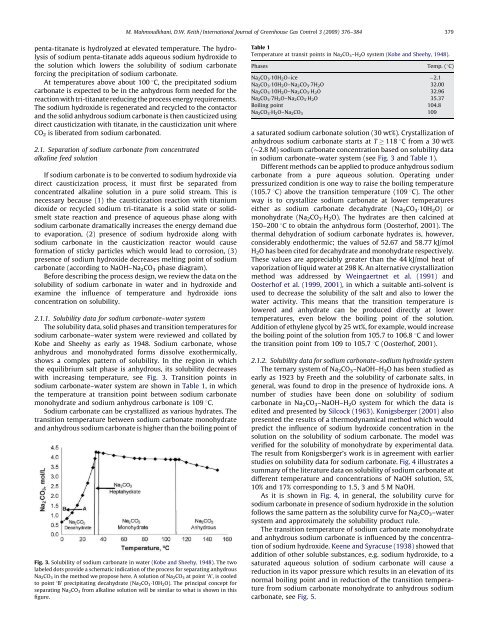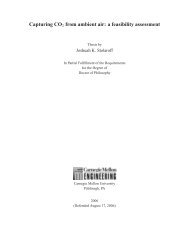Low-energy sodium hydroxide recovery for CO2 ... - David Keith
Low-energy sodium hydroxide recovery for CO2 ... - David Keith
Low-energy sodium hydroxide recovery for CO2 ... - David Keith
You also want an ePaper? Increase the reach of your titles
YUMPU automatically turns print PDFs into web optimized ePapers that Google loves.
M. Mahmoudkhani, D.W. <strong>Keith</strong> / International Journal of Greenhouse Gas Control 3 (2009) 376–384 379<br />
penta-titanate is hydrolyzed at elevated temperature. The hydrolysis<br />
of <strong>sodium</strong> penta-titanate adds aqueous <strong>sodium</strong> <strong>hydroxide</strong> to<br />
the solution which lowers the solubility of <strong>sodium</strong> carbonate<br />
<strong>for</strong>cing the precipitation of <strong>sodium</strong> carbonate.<br />
At temperatures above about 100 8C, the precipitated <strong>sodium</strong><br />
carbonate is expected to be in the anhydrous <strong>for</strong>m needed <strong>for</strong> the<br />
reaction with tri-titanate reducing the process <strong>energy</strong> requirements.<br />
The <strong>sodium</strong> <strong>hydroxide</strong> is regenerated and recycled to the contactor<br />
and the solid anhydrous <strong>sodium</strong> carbonate is then causticized using<br />
direct causticization with titanate, in the causticization unit where<br />
CO 2 is liberated from <strong>sodium</strong> carbonated.<br />
2.1. Separation of <strong>sodium</strong> carbonate from concentrated<br />
alkaline feed solution<br />
If <strong>sodium</strong> carbonate is to be converted to <strong>sodium</strong> <strong>hydroxide</strong> via<br />
direct causticization process, it must first be separated from<br />
concentrated alkaline solution in a pure solid stream. This is<br />
necessary because (1) the causticization reaction with titanium<br />
dioxide or recycled <strong>sodium</strong> tri-titanate is a solid state or solidsmelt<br />
state reaction and presence of aqueous phase along with<br />
<strong>sodium</strong> carbonate dramatically increases the <strong>energy</strong> demand due<br />
to evaporation, (2) presence of <strong>sodium</strong> <strong>hydroxide</strong> along with<br />
<strong>sodium</strong> carbonate in the causticization reactor would cause<br />
<strong>for</strong>mation of sticky particles which would lead to corrosion, (3)<br />
presence of <strong>sodium</strong> <strong>hydroxide</strong> decreases melting point of <strong>sodium</strong><br />
carbonate (according to NaOH–Na 2 CO 3 phase diagram).<br />
Be<strong>for</strong>e describing the process design, we review the data on the<br />
solubility of <strong>sodium</strong> carbonate in water and in <strong>hydroxide</strong> and<br />
examine the influence of temperature and <strong>hydroxide</strong> ions<br />
concentration on solubility.<br />
2.1.1. Solubility data <strong>for</strong> <strong>sodium</strong> carbonate–water system<br />
The solubility data, solid phases and transition temperatures <strong>for</strong><br />
<strong>sodium</strong> carbonate–water system were reviewed and collated by<br />
Kobe and Sheehy as early as 1948. Sodium carbonate, whose<br />
anhydrous and monohydrated <strong>for</strong>ms dissolve exothermically,<br />
shows a complex pattern of solubility. In the region in which<br />
the equilibrium salt phase is anhydrous, its solubility decreases<br />
with increasing temperature, see Fig. 3. Transition points in<br />
<strong>sodium</strong> carbonate–water system are shown in Table 1, in which<br />
the temperature at transition point between <strong>sodium</strong> carbonate<br />
monohydrate and <strong>sodium</strong> anhydrous carbonate is 109 8C.<br />
Sodium carbonate can be crystallized as various hydrates. The<br />
transition temperature between <strong>sodium</strong> carbonate monohydrate<br />
and anhydrous <strong>sodium</strong> carbonate is higher than the boiling point of<br />
Fig. 3. Solubility of <strong>sodium</strong> carbonate in water (Kobe and Sheehy, 1948). The two<br />
labeled dots provide a schematic indication of the process <strong>for</strong> separating anhydrous<br />
Na 2 CO 3 in the method we propose here. A solution of Na 2 CO 3 at point ‘A’, is cooled<br />
to point ‘B’ precipitating decahydrate (Na 2 CO 3 10H 2 O). The principal concept <strong>for</strong><br />
separating Na 2 CO 3 from alkaline solution will be similar to what is shown in this<br />
figure.<br />
Table 1<br />
Temperature at transit points in Na 2 CO 3 –H 2 O system (Kobe and Sheehy, 1948).<br />
Phases<br />
Temp. (8C)<br />
Na 2 CO 3 10H 2 O–ice 2.1<br />
Na 2 CO 3 10H 2 O–Na 2 CO 3 7H 2 O 32.00<br />
Na 2 CO 3 10H 2 O–Na 2 CO 3 H 2 O 32.96<br />
Na 2 CO 3 7H 2 O–Na 2 CO 3 H 2 O 35.37<br />
Boiling point 104.8<br />
Na 2 CO 3 H 2 O–Na 2 CO 3 109<br />
a saturated <strong>sodium</strong> carbonate solution (30 wt%). Crystallization of<br />
anhydrous <strong>sodium</strong> carbonate starts at T 118 8C from a 30 wt%<br />
(2.8 M) <strong>sodium</strong> carbonate concentration based on solubility data<br />
in <strong>sodium</strong> carbonate–water system (see Fig. 3 and Table 1).<br />
Different methods can be applied to produce anhydrous <strong>sodium</strong><br />
carbonate from a pure aqueous solution. Operating under<br />
pressurized condition is one way to raise the boiling temperature<br />
(105.7 8C) above the transition temperature (109 8C). The other<br />
way is to crystallize <strong>sodium</strong> carbonate at lower temperatures<br />
either as <strong>sodium</strong> carbonate decahydrate (Na 2 CO 3 10H 2 O) or<br />
monohydrate (Na 2 CO 3 H 2 O). The hydrates are then calcined at<br />
150–200 8C to obtain the anhydrous <strong>for</strong>m (Oosterhof, 2001). The<br />
thermal dehydration of <strong>sodium</strong> carbonate hydrates is, however,<br />
considerably endothermic; the values of 52.67 and 58.77 kJ/mol<br />
H 2 O has been cited <strong>for</strong> decahydrate and monohydrate respectively.<br />
These values are appreciably greater than the 44 kJ/mol heat of<br />
vaporization of liquid water at 298 K. An alternative crystallization<br />
method was addressed by Weingaertnet et al. (1991) and<br />
Oosterhof et al. (1999, 2001), in which a suitable anti-solvent is<br />
used to decrease the solubility of the salt and also to lower the<br />
water activity. This means that the transition temperature is<br />
lowered and anhydrate can be produced directly at lower<br />
temperatures, even below the boiling point of the solution.<br />
Addition of ethylene glycol by 25 wt%, <strong>for</strong> example, would increase<br />
the boiling point of the solution from 105.7 to 106.8 8C and lower<br />
the transition point from 109 to 105.7 8C (Oosterhof, 2001).<br />
2.1.2. Solubility data <strong>for</strong> <strong>sodium</strong> carbonate–<strong>sodium</strong> <strong>hydroxide</strong> system<br />
The ternary system of Na 2 CO 3 –NaOH–H 2 O has been studied as<br />
early as 1923 by Freeth and the solubility of carbonate salts, in<br />
general, was found to drop in the presence of <strong>hydroxide</strong> ions. A<br />
number of studies have been done on solubility of <strong>sodium</strong><br />
carbonate in Na 2 CO 3 –NaOH–H 2 O system <strong>for</strong> which the data is<br />
edited and presented by Silcock (1963). Konigsberger (2001) also<br />
presented the results of a thermodynamical method which would<br />
predict the influence of <strong>sodium</strong> <strong>hydroxide</strong> concentration in the<br />
solution on the solubility of <strong>sodium</strong> carbonate. The model was<br />
verified <strong>for</strong> the solubility of monohydrate by experimental data.<br />
The result from Konigsberger’s work is in agreement with earlier<br />
studies on solubility data <strong>for</strong> <strong>sodium</strong> carbonate. Fig. 4 illustrates a<br />
summary of the literature data on solubility of <strong>sodium</strong> carbonate at<br />
different temperature and concentrations of NaOH solution, 5%,<br />
10% and 17% corresponding to 1.5, 3 and 5 M NaOH.<br />
As it is shown in Fig. 4, in general, the solubility curve <strong>for</strong><br />
<strong>sodium</strong> carbonate in presence of <strong>sodium</strong> <strong>hydroxide</strong> in the solution<br />
follows the same pattern as the solubility curve <strong>for</strong> Na 2 CO 3 –water<br />
system and approximately the solubility product rule.<br />
The transition temperature of <strong>sodium</strong> carbonate monohydrate<br />
and anhydrous <strong>sodium</strong> carbonate is influenced by the concentration<br />
of <strong>sodium</strong> <strong>hydroxide</strong>. Keene and Syracuse (1938) showed that<br />
addition of other soluble substances, e.g. <strong>sodium</strong> <strong>hydroxide</strong>, to a<br />
saturated aqueous solution of <strong>sodium</strong> carbonate will cause a<br />
reduction in its vapor pressure which results in an elevation of its<br />
normal boiling point and in reduction of the transition temperature<br />
from <strong>sodium</strong> carbonate monohydrate to anhydrous <strong>sodium</strong><br />
carbonate, see Fig. 5.








